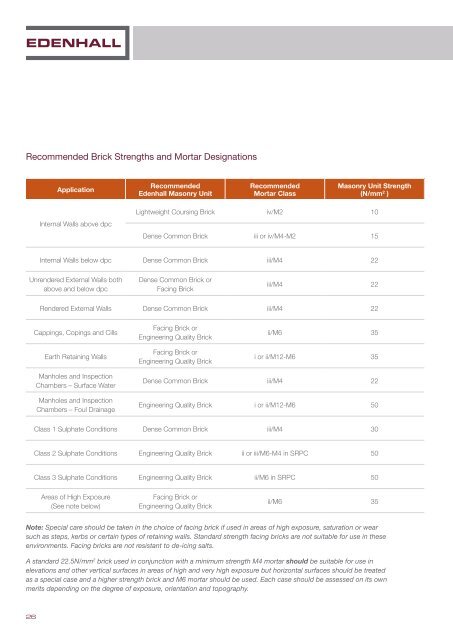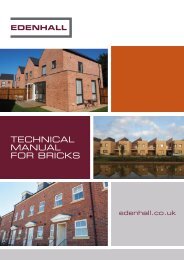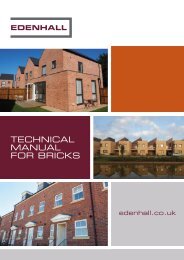Create successful ePaper yourself
Turn your PDF publications into a flip-book with our unique Google optimized e-Paper software.
Recommended Brick Strengths and Mortar Designations<br />
Application<br />
Recommended<br />
<strong>Edenhall</strong> Masonry Unit<br />
Recommended<br />
Mortar Class<br />
Masonry Unit Strength<br />
(N/mm 2 )<br />
Internal Walls above dpc<br />
Lightweight Coursing Brick iv/M2 10<br />
Dense Common Brick iii or iv/M4-M2 15<br />
Internal Walls below dpc Dense Common Brick iii/M4 22<br />
Unrendered External Walls both<br />
above and below dpc<br />
Dense Common Brick or<br />
Facing Brick<br />
iii/M4 22<br />
Rendered External Walls Dense Common Brick iii/M4 22<br />
Cappings, Copings and Cills<br />
Earth Retaining Walls<br />
Facing Brick or<br />
Engineering Quality Brick<br />
Facing Brick or<br />
Engineering Quality Brick<br />
ii/M6 35<br />
i or ii/M12-M6 35<br />
Manholes and Inspection<br />
Chambers – Surface Water<br />
Manholes and Inspection<br />
Chambers – Foul Drainage<br />
Dense Common Brick iii/M4 22<br />
Engineering Quality Brick i or ii/M12-M6 50<br />
Class 1 Sulphate Conditions Dense Common Brick iii/M4 30<br />
Class 2 Sulphate Conditions Engineering Quality Brick ii or iii/M6-M4 in SRPC 50<br />
Class 3 Sulphate Conditions Engineering Quality Brick ii/M6 in SRPC 50<br />
Areas of High Exposure<br />
(See note below)<br />
Facing Brick or<br />
Engineering Quality Brick<br />
ii/M6 35<br />
Note: Special care should be taken in the choice of facing brick if used in areas of high exposure, saturation or wear<br />
such as steps, kerbs or certain types of retaining walls. Standard strength facing bricks are not suitable for use in these<br />
environments. Facing bricks are not resistant to de-icing salts.<br />
A standard 22.5N/mm 2 brick used in conjunction with a minimum strength M4 mortar should be suitable for use in<br />
elevations and other vertical surfaces in areas of high and very high exposure but horizontal surfaces should be treated<br />
as a special case and a higher strength brick and M6 mortar should be used. Each case should be assessed on its own<br />
merits depending on the degree of exposure, orientation and topography.<br />
26







